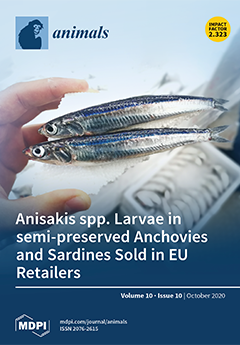Salmonella spp. contaminates egg and poultry meat leading to foodborne infections in humans. The emergence of antimicrobial-resistant strains has limited the use of antimicrobials. We aimed to determine the effects of the food supplement, fermented defatted ‘alperujo’ (FDA), a modified olive oil by-product,
[...] Read more.
Salmonella spp. contaminates egg and poultry meat leading to foodborne infections in humans. The emergence of antimicrobial-resistant strains has limited the use of antimicrobials. We aimed to determine the effects of the food supplement, fermented defatted ‘alperujo’ (FDA), a modified olive oil by-product, on
Salmonella Typhimurium colonisation in broilers. One hundred and twenty 1-day-old broilers were divided into four experimental groups—two control groups and two treated groups, and challenged with
S. Typhimurium at day 7 or 21. On days 7, 14, 21, 28, 35, and 42 of life, duodenum and cecum tissue samples were collected for histopathological and histomorphometric studies. Additionally, cecum content was collected for
Salmonella spp. detection by culture and qPCR, and for metagenomic analysis. Our results showed a significant reduction of
Salmonella spp. in the cecum of 42-day-old broilers, suggesting that fermented defatted ‘alperujo’ limits
Salmonella Typhimurium colonization in that cecum and may contribute to diminishing the risk of carcass contamination at the time of slaughter. The improvement of the mucosal integrity, observed histologically and morphometrically, may contribute to enhancing intestinal health and to limiting
Salmonella spp. colonisation in the host, mitigating production losses. These results could provide evidence that FDA would contribute to prophylactic and therapeutic measures to reduce salmonellosis prevalence in poultry farms.
Full article






